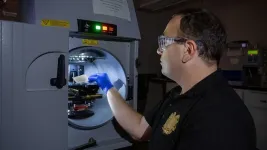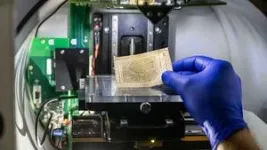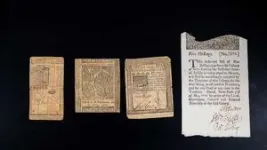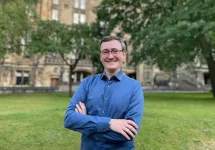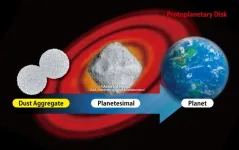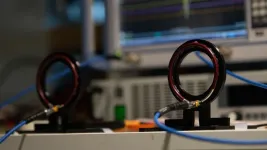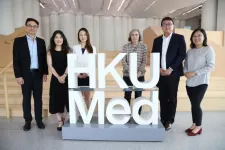(Press-News.org) Benjamin Franklin may be best known as the creator of bifocals and the lightning rod, but a group of University of Notre Dame researchers suggest he should also be known for his innovative ways of making (literal) money.
During his career, Franklin printed nearly 2,500,000 money notes for the American Colonies using what the researchers have identified as highly original techniques, as reported in a study published this week in the Proceedings of the National Academy of Sciences.
The research team, led by Khachatur Manukyan, an associate research professor in the Department of Physics and Astronomy, has spent the past seven years analyzing a trove of nearly 600 notes from the Colonial period, which is part of an extensive collection developed by the Hesburgh Libraries’ Rare Books and Special Collections. The Colonial notes span an 80-year period and include notes printed by Franklin’s network of printing shops and other printers, as well as a series of counterfeit notes.
Manukyan explained that the effort to print money for the fledgling Colonial monetary system was important to Franklin not just as a printer but as a statesman as well.
“Benjamin Franklin saw that the Colonies’ financial independence was necessary for their political independence. Most of the silver and gold coins brought to the British American colonies were rapidly drained away to pay for manufactured goods imported from abroad, leaving the Colonies without sufficient monetary supply to expand their economy,” Manukyan said.
However, one major problem stood in the way of efforts to print paper money: counterfeiting. When Franklin opened his printing house in 1728, paper money was a relatively new concept. Unlike gold and silver, paper money’s lack of intrinsic value meant it was constantly at risk of depreciating. There were no standardized bills in the Colonial period, leaving an opportunity for counterfeiters to pass off fake bills as real ones. In response, Franklin worked to embed a suite of security features that made his bills distinctive.
“To maintain the notes’ dependability, Franklin had to stay a step ahead of counterfeiters,” said Manukyan. “But the ledger where we know he recorded these printing decisions and methods has been lost to history. Using the techniques of physics, we have been able to restore, in part, some of what that record would have shown.”
Manukyan and his team employed cutting-edge spectroscopic and imaging instruments housed in the Nuclear Science Laboratory and four Notre Dame research core facilities: the Center for Environmental Science and Technology, the Integrated Imaging Facility, the Materials Characterization Facility and the Molecular Structure Facility. The tools enabled them to get a closer look than ever at the inks, paper and fibers that made Franklin’s bills distinctive and hard to replicate.
One of the most distinctive features they found was in Franklin’s pigments. Manukyan and his team determined the chemical elements used for each item in Notre Dame’s collection of Colonial notes. The counterfeits, they found, have distinctive high quantities of calcium and phosphorus, but these elements are found only in traces in the genuine bills.
Their analyses revealed that although Franklin used (and sold) “lamp black,” a pigment created by burning vegetable oils, for most printing, Franklin’s printed currency used a special black dye made from graphite found in rock. This pigment is also different from the “bone black” made from burned bone, which was favored both by counterfeiters and by those outside Franklin’s network of printing houses.
Another of Franklin’s innovations was in the paper itself. The invention of including tiny fibers in paper pulp — visible as pigmented squiggles within paper money — has often been credited to paper manufacturer Zenas Marshall Crane, who introduced this practice in 1844. But Manukyan and his team found evidence that Franklin was including colored silks in his paper much earlier.
The team also discovered that notes printed by Franklin’s network have a distinctive look due to the addition of a translucent material they identified as muscovite. The team determined that Franklin began adding muscovite to his papers and the size of this muscovite crystals in his paper increased over time. The team speculates that Franklin initially began adding muscovite to make the printed notes more durable but continued to add it when it proved to be a helpful deterrent to counterfeiters.
Manukyan said that it is unusual for a physics lab to work with rare and archival materials, and this posed special challenges.
“Few scientists are interested in working with materials like these. In some cases, these bills are one-of-a-kind. They must be handled with extreme care, and they cannot be damaged. Those are constraints that would turn many physicists off to a project like this,” he said.
But for him, the project is a testament to the value of interdisciplinary work.
“We were fortunate to have student researchers on this project with interests both in physics as well as in history and art conservation. And the core research facilities as well as the Rare Books and Special Collections team were incredible research partners. Without an uncommon level of collaboration across disciplines, our discoveries would not have been possible.”
In addition to lead investigator Manukyan, the research team for this project included Armenuhi Yeghishyan, a laboratory technician in the Department of Physics and Astronomy; Ani Aprahamian, the Frank M. Freimann Professor of Physics and concurrent professor in the Department of Chemistry and Biochemistry; Louis Jordan, an associate University librarian emeritus for academic services and collections; Michael Kurkowski, a former undergraduate researcher studying physics and mathematics; Mark Raddell, a former undergraduate researcher studying finance and physics who is now a consultant at Deloitte; Laura Richter Le, a former undergraduate researcher who is now a graduate student at the Conservation Center at New York University’s Institute of Fine Arts; Zachary D. Schultz, a former associate professor at Notre Dame who is now a faculty member at the Ohio State University; Liam Spillane, who works at Gatan Inc.; and Michael Wiescher, the Frank M. Freimann Professor of Physics.
This research project was funded by an internal grant from Notre Dame Research. For more information on the Nuclear Science Laboratory’s work investigating historical materials, visit sites.nd.edu/kmanukyan/research/.
END
Researchers decipher the secrets of Benjamin Franklin’s paper money
A rare window into the early American monetary history — thanks to techniques from physics
2023-07-21
ELSE PRESS RELEASES FROM THIS DATE:
KIPA potentially predicts chemotherapy response in triple negative breast cancer
2023-07-21
Researchers at Baylor College of Medicine and collaborating institutions are developing a strategy to predict the response of triple negative breast cancer (TNBC) to chemotherapy, which would be a valuable tool for physicians deciding on the treatment with better probability of success on an individual basis. The study appears in Cancer Research Communications, a journal of the American Association for Cancer Research.
“Multiple research innovations in cancer diagnostics are on display in this work,” said co-corresponding author Dr. Matthew Ellis, member of the Lester and Sue Smith Breast Center and the Dan ...
On the hunt for strangeness
2023-07-21
NEWPORT NEWS, VA – Peter Hurck has been searching for strange particles, named such because they contain strange quarks, since beginning work on his Ph.D. As the 2023 Jefferson Science Associates (JSA) Postdoctoral Prize winner, he’ll continue conducting data analyses to identify strange particles and learn about their properties.
Many of these experiments that contribute to the data Hurck is analyzing are conducted at the U.S. Department of Energy's Thomas Jefferson National Accelerator Facility, which is managed and operated by JSA.
“Strangeness hasn't been studied as much because it's quite ...
ASBMB expresses concerns on proposed NIH budget cuts
2023-07-21
On July 19, the American Society for Biochemistry and Molecular Biology released a statement expressing concerns on the National Institutes of Health budget proposed in the House Labor, Health and Human Services, Education and Related Agencies funding bill. The bill allocates only $44.7 billion for NIH, which represents a 6.4% decrease from fiscal year 2023 levels and would have detrimental repercussions for the National Institute of Allergy and Infectious Diseases, the National Institute of Neurological Diseases and Stroke, the National Cancer Institute and the National Institute ...
To stick or to bounce: Size determines the stickiness of cosmic dust aggregates
2023-07-21
Microparticle dust aggregates, which are thought to play a role in the formation of new planets, are less likely to stick together after a collision when the aggregates are larger.
Current evidence suggests that microparticles of cosmic dust collide and stick together to form larger dust aggregates that may eventually combine and develop into planets. Numerical models that accurately characterize the conditions required for colliding microparticle aggregates to stick together, rather than bounce apart, are therefore ...
Long-term changes in waves and storm surges have not impacted global coastlines
2023-07-21
Changes in ocean wave and storm conditions have not caused long-term impacts on sandy coastlines in the past 30 years, a new study has found.
Published today in Scientific Reports, the study draws on data from 30 years of global satellite and model studies to investigate whether changes in ocean wave conditions will have an impact on the stability of coastal environments.
The compounding effect of climate change driven variations in waves, storm surge and sea level rise is projected to lead to shoreline position change along most of the world’s sandy coasts.
A team ...
Subseasonal transition of sea-ice anomalies in the Barents–Kara Sea in winter modulated by the “warm Arctic–cold Eurasia” pattern
2023-07-21
The “warm Arctic–cold Eurasia” is one of the most significant patterns of winter climate system changes in the mid-high latitudes of the Northern Hemisphere. In winter 2020/21, this large-scale pattern underwent a significant and intense subseasonal reversal between the early and late winter. At the same time, the sea-ice anomalies in the Barents–Kara Sea changed from being significantly negative in early winter to positive in late winter. For the slow-varying process of winter sea ice, the rapid freezing ...
Miocene period fossil forest of Wataria found in Japan
2023-07-21
An exquisitely preserved fossil forest from Japan provides missing links and helps reconstruct a whole Eurasia plant from the late Miocene epoch.
Complete plant fossils are seldom found as a single piece, as wood, leaves, flowers, fruits, seeds, or pollen detach easily from plants. This results in leaves and trunks having separate scientific names. Putting together the different parts to reveal the complete plant is like putting together a jigsaw puzzle. Connecting these dots and reconstructing plants is important to establish their taxonomic identity—their ...
Going the distance for better wireless charging
2023-07-21
A better way to wirelessly charge over long distances has been developed at Aalto University. Engineers have optimized the way antennas transmitting and receiving power interact with each other, making use of the phenomenon of “radiation suppression”. The result is a better theoretical understanding of wireless power transfer compared to the conventional inductive approach, a significant advancement in the field.
Charging over short distances, such as through induction pads, uses magnetic near fields to transfer power with high efficiency, but at longer distances the efficiency dramatically drops. New research shows that this high efficiency ...
Are shared medical appointments the key to solving global healthcare shortages?
2023-07-21
This research was conducted by Nazlı Sönmez, ESMT Berlin; Kavitha Srinivasan and Rengaraj Venkatesh, Aravind Eye Hospital (India); Ryan W. Buell, Harvard Business School; and Kamalini Ramdas, London Business School. The researchers wanted to understand the impact of shared medical appointments on patient experience (knowledge gained and satisfaction) and behavior (follow-up rates and medication compliance rates).
In shared medical appointments (SMAs), patients with the same medical condition meet with the physician in a group, with each patient receiving attention in turn. The physician shares information customized to a patient’s specific needs as well ...
HKUMed finds metformin could promote healthy ageing based on genetics
2023-07-21
A research team from the School of Public Health, LKS Faculty of Medicine of the University of Hong Kong (HKUMed), provides genetic evidence that metformin might promote healthy ageing using a cohort study of more than 300,000 participants of European descent (UK Biobank). This proof-of-concept work supports further clinical research into the drug repositioning of metformin in healthy longevity. The findings are now published in The Lancet Healthy Longevity, a leading peer-reviewed, international journal in the field of geriatrics and gerontology [link to the publication].
Background
Metformin is a first-line medication for type 2 diabetes. ...
LAST 30 PRESS RELEASES:
New software sheds light on cancer’s hidden genetic networks
UT Health San Antonio awarded $3 million in CPRIT grants to bolster cancer research and prevention efforts in South Texas
Third symposium spotlights global challenge of new contaminants in China’s fight against pollution
From straw to soil harmony: International team reveals how biochar supercharges carbon-smart farming
Myeloma: How AI is redrawing the map of cancer care
Manhattan E. Charurat, Ph.D., MHS invested as the Homer and Martha Gudelsky Distinguished Professor in Medicine at the University of Maryland School of Medicine
Insilico Medicine’s Pharma.AI Q4 Winter Launch Recap: Revolutionizing drug discovery with cutting-edge AI innovations, accelerating the path to pharmaceutical superintelligence
Nanoplastics have diet-dependent impacts on digestive system health
Brain neuron death occurs throughout life and increases with age, a natural human protein drug may halt neuron death in Alzheimer’s disease
SPIE and CLP announce the recipients of the 2025 Advanced Photonics Young Innovator Award
Lessons from the Caldor Fire’s Christmas Valley ‘Miracle’
Ant societies rose by trading individual protection for collective power
Research reveals how ancient viral DNA shapes early embryonic development
A molecular gatekeeper that controls protein synthesis
New ‘cloaking device’ concept to shield sensitive tech from magnetic fields
Researchers show impact of mountain building and climate change on alpine biodiversity
Study models the transition from Neanderthals to modern humans in Europe
University of Phoenix College of Doctoral Studies releases white paper on AI-driven skilling to reduce burnout and restore worker autonomy
AIs fail at the game of visual “telephone”
The levers for a sustainable food system
Potential changes in US homelessness by ending federal support for housing first programs
Vulnerability of large language models to prompt injection when providing medical advice
Researchers develop new system for high-energy-density, long-life, multi-electron transfer bromine-based flow batteries
Ending federal support for housing first programs could increase U.S. homelessness by 5% in one year, new JAMA study finds
New research uncovers molecular ‘safety switch’ shielding cancers from immune attack
Bacteria resisting viral infection can still sink carbon to ocean floor
Younger biological age may increase depression risk in older women during COVID-19
Bharat Innovates 2026 National Basecamp Showcases India’s Most Promising Deep-Tech Ventures
Here’s what determines whether your income level rises or falls
SCIE indexation achievement: Celebrate with Space: Science & Technology
[Press-News.org] Researchers decipher the secrets of Benjamin Franklin’s paper moneyA rare window into the early American monetary history — thanks to techniques from physics
